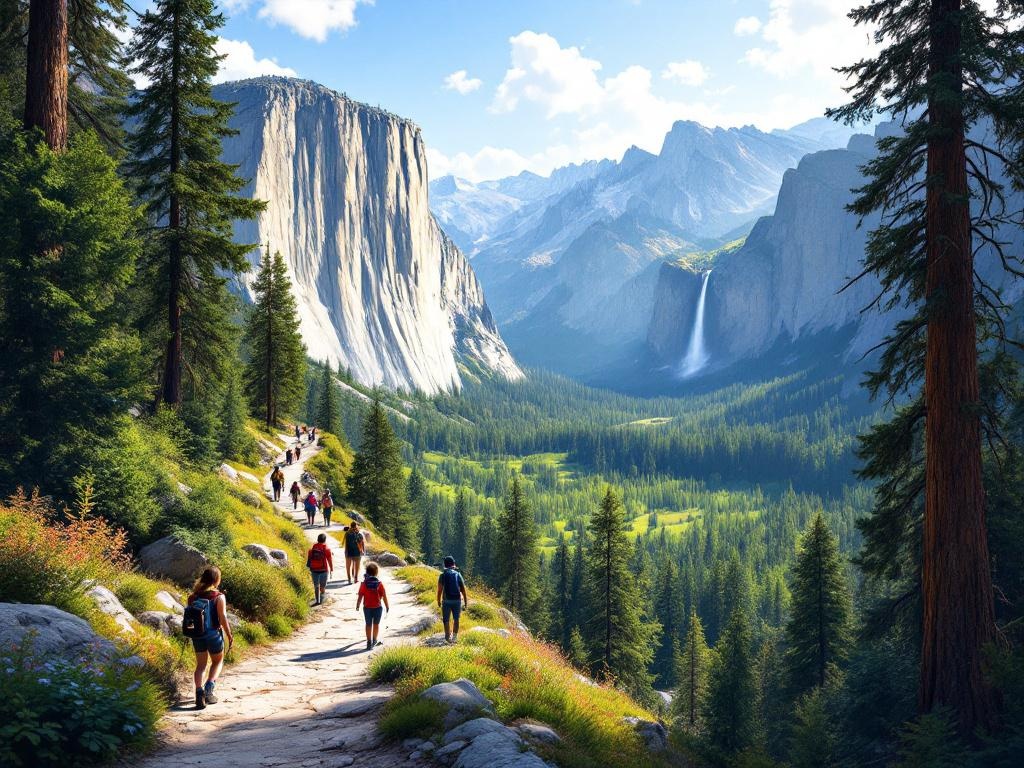Hiking in Yosemite National Park
Discover Yosemite National Park’s 800 miles of hiking trails, from easy family strolls to challenging climbs like Half Dome. Explore iconic waterfalls, stunning granite peaks, and giant sequoia groves. Find the perfect trail for your skill level, from beginner-friendly paths to strenuous adventures. Plan your unforgettable Yosemite hiking experience today and explore trails like Bridalveil Fall and Yosemite Falls. Learn essential tips for a safe and enjoyable adventure.
Important information

- Yosemite National Park has over 800 miles of trails, ranging from easy to strenuous, suitable for all skill levels.
- Check the park’s website for trail conditions, closures, and permit requirements before your hike.
- Wilderness permits are required for overnight backpacking trips and can be reserved up to six months in advance on Recreation.gov.
- Essential hiking gear includes sturdy footwear, navigation tools (map, compass, GPS), a first-aid kit, and bear canisters.
- Practice Leave No Trace principles and be aware of bear safety guidelines for a safe and enjoyable experience.
Introduction to Hiking in Yosemite National Park
Yosemite National Park, a premier US hiking destination, welcomes over 3.5 million visitors annually to explore its expansive 800-mile trail system. These trails offer options for hikers of all abilities, from novice to expert. Use our travel entry requirements checker available on Passport Free Countries. Check if you need a visa or other travel documents via Passport Free Countries: https://passportfreecountries.org
Understanding Yosemite’s Diverse Hiking Trails
Yosemite National Park offers a diverse network of trails for all skill levels. Easy trails are perfect for families and beginners. Moderate trails offer a suitable challenge for most. Experienced hikers can tackle strenuous trails with rewarding vistas. Choose a trail that matches your fitness level and start your Yosemite adventure.
Easy Trails for Beginners and Families
Looking for an easy hike in Yosemite? The Bridalveil Fall, Lower Yosemite Fall, and Cook’s Meadow Loop trails are perfect for families and beginners. Bridalveil Fall is even known as the park’s best family hike.
Moderate Hikes for Intermediate Hikers
Planning a Yosemite hike? For a moderate outing, consider the Mirror Lake Loop or the Valley Loop Trail. Seeking a tougher climb? The Yosemite Falls Trail offers a rewarding, albeit challenging, experience. Remember to check trail conditions and closures before heading out, and choose a path that aligns with your fitness level for a safe and enjoyable adventure.
Strenuous Trails for Advanced Hikers
Snow Creek, Four Mile, and Half Dome Trails offer strenuous hikes, best suited for experienced hikers.
Half Dome, with its particularly challenging climb, is an ideal adventure for seasoned adventurers.
Exploring Yosemite Valley: The Heart of Hiking
Yosemite Valley offers a diverse range of hiking experiences, from leisurely strolls to challenging climbs. Over a dozen trailheads provide access to breathtaking vistas. Families will enjoy easy options like the Lower Yosemite Fall Trail, while seasoned hikers can test their mettle on the Four Mile Trail. For a moderate challenge, consider the Mist Trail to Vernal and Nevada Falls. Remember to check the park’s website for current trail conditions and closures before heading out.
Easy Trails
The valley floor boasts numerous easy trails perfect for casual walkers and families with young children. The paved, half-mile Bridalveil Fall Trail is an easy, family-friendly option suitable for all ages. It leads to the iconic Bridalveil Fall, a must-see for any Yosemite visitor.
Challenging Hikes
Those seeking a more strenuous workout can ascend higher for panoramic valley views. For a truly unforgettable experience, tackle the iconic Half Dome hike via the Mist Trail. This strenuous 14-16 mile roundtrip involves cable-assisted climbing to the summit, rewarding hikers with unparalleled valley views. Permits are required, so plan ahead.
Choose your trail. Yosemite Valley offers various trails, from easy walks to challenging climbs. Consider your fitness level and experience when selecting a trail.
Check trail conditions. Visit the park’s website for current trail conditions and closures before heading out. This will ensure a safe and enjoyable hike.
Plan your hike. Detailed trail maps and descriptions are available on the park’s website. Use these resources to plan your adventure and choose a trail that suits your interests.
Yosemite Valley Day Hikes
Yosemite Valley provides a variety of trails for day hikes. For families, the easy one-mile Lower Yosemite Fall Loop is an excellent choice. Those looking for a moderate challenge can hike the Mirror Lake Loop, a two-mile trek that can be extended to five miles by reaching the lake’s far shore. For experienced hikers, strenuous options like the challenging 4.8-mile (one-way) Four Mile Trail are available. Before your hike, remember to check the park website for current trail conditions and permit requirements.
Family-Friendly Hikes: Bridalveil Fall Trail
The easy Bridalveil Fall Trail is a short, half-mile loop, perfect for families with children.
Iconic Hike: Half Dome via the Mist Trail
Yosemite’s iconic Half Dome hike, accessed via the Mist Trail, is a challenging but rewarding adventure best suited for experienced hikers. The trail passes Vernal and Nevada Falls, two of the park’s most stunning waterfalls.
Best Hiking Destinations in Yosemite National Park
Yosemite National Park offers a variety of incredible hikes for all skill levels. While Half Dome presents a challenging climb for experienced hikers, gentler options abound. Explore the scenic trails of Tuolumne Meadows or the Glen Aulin High Sierra Camp. Don’t miss Yosemite Falls, North America’s tallest waterfall. Cathedral Lakes and Mirror Lake also offer beautiful trails perfect for less experienced hikers.
Challenging Hike
Half Dome: A challenging climb for experienced hikers.
Less Challenging Hikes
- Tuolumne Meadows: Explore the scenic trails.
- Glen Aulin High Sierra Camp: Another great option for a scenic hike.
- Yosemite Falls: Don’t miss North America’s tallest waterfall.
- Cathedral Lakes: Beautiful trails perfect for less experienced hikers.
- Mirror Lake: Another beautiful, less challenging hike.
Half Dome: A Challenge for Advanced Hikers
Scaling Half Dome is a challenging hike recommended for experienced hikers. The 14-to-16.4-mile round trip requires significant physical exertion and thorough preparation.
Tuolumne Meadows and Glen Aulin High Sierra Camp
Tuolumne Meadows, a high-elevation hiker’s paradise, offers numerous trails to explore. For a unique adventure, consider hiking to Glen Aulin High Sierra Camp, a backcountry lodge. Remember to check trail conditions and regulations before your visit to ensure a safe and enjoyable experience.
Yosemite Falls: North America’s Tallest Waterfall
Yosemite Falls, North America’s tallest measured waterfall, offers hikers an unforgettable experience. The trail to the top reveals breathtaking vistas around every bend, showcasing the falls’ majesty. Hikers can enjoy various trails, depending on their experience level, ranging from easy strolls to challenging climbs. The challenging hike to the top of Yosemite Falls is strenuous but rewarding, offering unparalleled views of Yosemite Valley and the High Sierra. For those seeking a less demanding experience, the lower Yosemite Fall Trail provides a pleasant loop with stunning views of the lower falls. No matter your fitness level, witnessing the power and beauty of Yosemite Falls is a must-do for any visitor to Yosemite National Park.
Scenic Trails: Cathedral Lakes and Mirror Lake
Cathedral Lakes
For those seeking a moderately challenging hike with rewarding views, Cathedral Lakes is an excellent choice. Hikers can enjoy breathtaking views of alpine lakes and granite peaks.
Mirror Lake
If a leisurely stroll is more your style, Mirror Lake offers an easy, paved path. The lake is known for its stunning reflections of Half Dome in the calm water, particularly during the early morning hours.
Planning Your Hiking Adventure in Yosemite
Planning your Yosemite hiking adventure? Secure a wilderness permit through the park’s reservation system. Pack appropriate gear, including bear canisters, sturdy footwear, and navigation tools. Familiarize yourself with essential safety tips and Leave No Trace principles to minimize your impact on the environment. Bear safety and general wildlife awareness are crucial. Learn how to store food properly and react calmly in wildlife encounters. For detailed information on permits, safety regulations, and bear safety, visit the park’s official website. Use our travel entry requirements checker available on Passport Free Countries. Check if you need a visa or other travel documents via Passport Free Countries: https://passportfreecountries.org
Wilderness Permits and Reservation System
Planning an overnight backpacking trip in Yosemite’s wilderness? You’ll need a permit. Reserve yours up to six months beforehand on Recreation.gov – it’s highly recommended. While walk-up permits exist, they’re limited and not guaranteed. Before your trip, visit the park website for permit regulations, quotas, and any reservation updates.
Essential Hiking Gear and Safety Tips
Navigation: Use a map, compass, or GPS device to stay oriented in Yosemite’s wilderness.
First Aid: Carry a well-stocked first-aid kit containing bandages, antiseptic wipes, pain relievers, and blister treatment.
Light: Pack a headlamp or flashlight with extra batteries for navigating in darkness or during unexpected delays.
Sun Protection: Protect yourself from the sun with sunscreen, sunglasses, and a hat, even on cloudy days.
Sustenance: Bring plenty of water and high-energy snacks to maintain your energy levels.
Footwear: Wear sturdy hiking boots with good ankle support and traction for Yosemite’s varied terrain.
Clothing: Pack layers of clothing to adapt to Yosemite’s rapidly changing weather conditions.
Safety Plan: Inform someone about your hiking plans, including your route and estimated return time.
Bear Safety and Wildlife Awareness
Securely store your food to protect yourself and the bears.
Hike only on marked trails.
Always inform someone of your itinerary.
Consult the park’s website for trail conditions and regulations before embarking on your adventure.
Leave No Trace Principles
Plan and prepare for your trip.
Camp and hike only on durable surfaces, such as established trails and campsites.
Pack out all trash, leaving no trace behind.
Minimize campfire impact by using existing fire rings or a camp stove.
If a fire is necessary, keep it small and contained.
Respect wildlife by observing from afar and refraining from feeding them.
Be considerate of fellow visitors by minimizing noise and respecting their space.
Seasonal Hiking Tips for Yosemite National Park
Yosemite’s weather dramatically shifts throughout the year, significantly impacting trail conditions. Here’s a seasonal overview:
Spring
Spring offers breathtaking waterfalls and colorful wildflowers. Higher elevations might still be snow-covered.
Summer
Summer is perfect for high-elevation hikes. Be ready for hot temperatures.
Fall
Fall provides crisp air, stunning foliage, and fewer crowds on the trails.
Winter
Winter transforms Yosemite into a wonderland for snowshoeing and cross-country skiing. Many trails become inaccessible.
Trail maps are crucial for navigating the park. Here’s how to ensure you have access to them:
- Obtain physical maps at visitor centers.
- Utilize GPS devices and mobile apps, particularly helpful in areas with spotty cell service.
For your safety, always inform someone of your hiking plans, including your estimated return time.
Weather Considerations and Best Times to Hike
Yosemite National Park is a hiker’s paradise from spring through fall. Spring hikers are rewarded with cascading waterfalls and vibrant wildflowers. Summer brings warm sunshine, but also larger crowds. For a quieter experience with breathtaking autumn leaves, visit in the fall. While winter hiking is possible at lower elevations, higher trails may be inaccessible due to snow. Before any hike, always check the weather forecast and trail conditions, and inform someone of your itinerary, especially if hiking alone. Here’s a look at what each season offers:
Spring
Experience the park’s waterfalls at their peak flow, complemented by colorful wildflowers. Trails are generally accessible, but some higher elevation paths may still have snow early in the season.
Summer
Enjoy warm weather ideal for hiking, but expect larger crowds, especially on popular trails. Start hikes early in the morning to avoid both the heat and the busiest times.
Fall
Hike amid breathtaking autumn foliage as the crowds thin out. Crisp air and cooler temperatures make for pleasant hiking conditions.
Winter
Lower elevation trails offer opportunities for winter hiking. Be prepared for snow and ice, and check trail conditions before heading out. Higher elevation trails are typically inaccessible.
Important Hiking Tips: Always check the weather forecast and trail conditions before your hike. Inform someone of your planned route and estimated return time, particularly if hiking solo.
Trail Maps and Navigation
Plan your perfect Yosemite hike with these resources:
- Detailed trail maps: Available at visitor centers and park entrances, these maps outline routes, difficulty levels, and points of interest.
- Mobile GPS apps: Identify trails and track your progress in real-time.
- Pre-planning: Essential for a safe and enjoyable experience. Familiarize yourself with your chosen route and map.
- Trail conditions and posted signs: Check for current updates, additional guidance, and distance markers before starting your hike.











